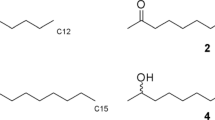Abstract
A method for determining the authenticity of subterranean termite trail pheromones is suggested and utilized to verify the presence of trail pheromones inReticulitermes virginicus, R. flavipes, andR. tibialis. In addition, a possible trail pheromone has been demonstrated forCoptotermes formosanus. A choice bioassay method shows that the above trail pheromones are species specific.
Similar content being viewed by others
References
Beard, R.L. 1974. Termite biology and bait-block method of control. Bulletin 748, Connecticut Agricultural Exp. Station, New Haven, Connecticut.
Becker, G. andPetrowitz, H.J. 1967. Auf termiten spurbildend wirkende Stoffe.Naturwissenschaften 54:16–17.
Birch, A.J., Chamberlain, K.B., Moore, B.P., andPowell, V.H. 1970. Termit eattractants inSantalum spicatum.Australian J. Chem. 23:2337–2341.
Birch, A.J., Brown, W.V., Corrie, J.E.T., andMoore, B.P. 1972. Neocembrene-A, a termite trail pheromone.J. Chem. Soc., Perkin Trans. I, 2653–2658.
Blum, M.S. andBrand, J.M. 1972. Social insect pheromones: their chemistry and function.Am. Zool. 12:553–576.
Esenther, G.R. andGray, D.E. 1968. Subterranean termite studies in Southern Ontario.Can. Entomologist 100:827–834.
Esenther, G.R. andBeal, R.H. 1974. Attractant-mirex bait suppresses activity ofReticulitermes spp.J. Econ. Entomol. 67:85–88.
Hewitt, P.H., Nel, J.J.C., andConradie, S. 1969. The role of chemicals in communication in the harvester termitesHodotermes mossambicus (Hagen) andTrinervitermes trinervoides (Sjostedt).Insectes Sociaux. 16:79–86.
Hummel, H. 1968. Chemische anreicherungsversuche zum Studium eines spurwirksamen pheromons der termiteZootermopsis nevadensis Hagen.Insectes Sociaux 15:213–216.
Karlson, P., Luscher, M., andHummel, H. 1968. Extraction und biologische auswertung des spurpheromons der termiteZootermopsis nevadensis.J. Insect Physiol. 14:1761–1763.
Matsumura, F., Coppel, H.C., andTai, A. 1968. Isolation and identification of termite trail-following pheromone.Nature 219:963–964.
Matsumura, F., Tai, A., andCoppel, H.C. 1969. Termite trail-following substance, isolation and purification fromReticultermes virginicus and fungus infected wood.J. Econ. Entomol. 62:599–603.
Matsumura, F., Jewett, D.M., andCoppel, H.C. 1972. Interspecific response to synthetic trail-following substances.J. Econ. Entomol. 65:600–602.
Mertins, J.W., Coppel, H.C., andMatsumura, F. 1971. Sternal gland inCoptotermes formosanus (Isoptera, Rhinotermitidae).Ann. Entomol. Soc. Amer. 64:478–480.
Moore, B.P. 1966. Isolation of the scent-trail pheromone of an Australian termite.Nature (London) 211:746–747.
Moore, B.P. 1969. Biochemical studies in termites, pp. 407–432,in K. Krishna and F. M. Weesner (eds.),Biology of Termites, Vol. 1. Academic Press, New York.
Moore, B.P. 1974. Pheromones in the termite societies, pp. 250–266in M. C. Birch (ed.),Pheromones. American Elsevier Pub. Co., New York.
Shatov, K.S. 1974a. Experimental study of the trail reaction inAnacanthotermes ahngerianus Jacobson, pp. 121–133in E. Kh. Zolotarev (ed.),Termites. University Publishing House, Moscow.
Shatov, K.S. 1974b. Functions of the sternal gland in termitesAnacanthotermes ahngerianus Jacobson, belonging to different castes, pp. 134–140,in E. Kh. Zolotarev (ed.),Termites. University Publishing House, Moscow.
Siddall, J.B. 1970. Chemical aspects of hormonal interactions, pp. 281–306in E. Sondheimer and J. B. Simeone (eds.),Chemical Ecology. Academic Press, New York.
Smythe, R.V. andCoppel, H.C. 1966. A preliminary study of the sternal gland ofReticulitermes flavipes (Isoptera: Rhinotermitidae).Ann. Entomol. Soc. Am. 59:1008–1010.
Stuart, A.M. 1963. Origin of the trail in the termitesNasuititermes corniger (Motschulsky) andZootermopsis nevadensis (Hagen), Isoptera.Physiological Zoology 36:69–84.
Stuart, A.M. 1964. The structure and function of the sternal gland inZootermopsis nevadensis (Isoptera).Proc. Zool. Soc. London 143:43–52.
Stuart, A.M. 1969. Social behavior and communication, pp. 193–232,in K. Krishna and F. M. Weesner (eds.),Biology of Termites, Vol. 1. Academic Press, New York.
Tai, A., Matsumura, F., andCoppel, H.C. 1969. Chemical identification of the trail-following pheromone for a southern subterranean termite.J. Org. Chem. 34:2180–2182.
Tai, A., Matsumura, F., andCoppel, H.C. 1971. Synthetic analogues of the termite trail-following pheromone, structure and biological activity.J. Insect Physiol. 17:181–188.
Tschinkel, W.R. andClose, P.G. 1973. The trail pheromone of the termiteTrinervitermes trinervoides.J. Insect Physiol. 19:707–721.
Verron, H. andBarbier, M. 1962. L'hexene-3-ol-1, substance des termitesCalotermes flavicollis etMicrocerotermes edentatus.C.R. Acad. Sci. 254:4089–4091.
Watanabe, T. andCasida, J.E. 1963. Response ofReticulitermes flavipes to fractions from fungus infected wood and synthetic chemicals.J. Econ. Entomol. 56:300–307.
Yates, F. 1934. Contingency tables involving small numbers and the χ2 test.J. Roy. Stat. Soc. Suppl., 1:217–235.
Author information
Authors and Affiliations
Rights and permissions
About this article
Cite this article
Howard, R., Matsumura, F. & Coppel, H.C. Trail-following pheromones of the rhinotermitidae: Approaches to their authentication and specificity. J Chem Ecol 2, 147–166 (1976). https://doi.org/10.1007/BF00987738
Received:
Revised:
Issue Date:
DOI: https://doi.org/10.1007/BF00987738




